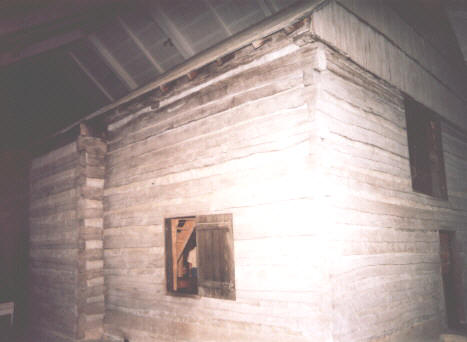Cane Ridge Meetinghouse
One Of The Earliest Churches Of Christ In America
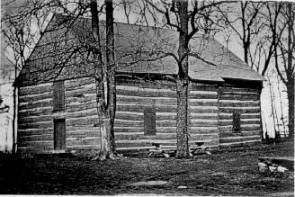
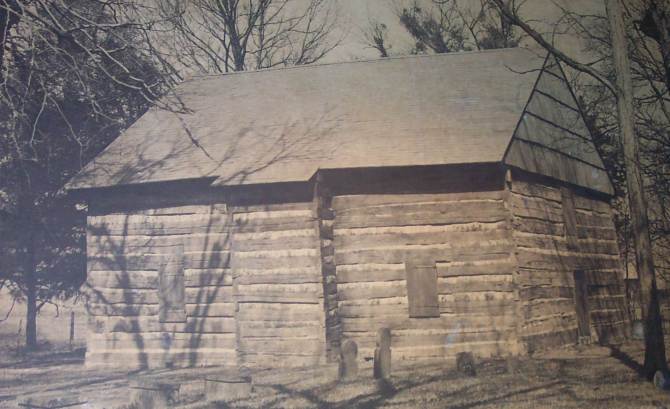
As The Meetinghouse Looked Before The Outer Edifice Was Built
![]()
Cane Ridge
The Cane Ridge Meetinghouse has become a significant historical site marking the beginning point of the Restoration appeal. The work of Barton Warren Stone began there six or eight years before Thomas and Alexander Campbell came to America from Ireland. Stone and his associates set in motion the scriptural process by which the New Testament church was restored after having lost its identity in the maze of denominationalism.
Robert Finley led a group of pioneer settlers from Pennsylvania and North Carolina in 1790 to the canebrakes of Bourbon and Nicholas counties in Kentucky. Finley set about to organize Presbyterian churches at Cane Ridge and Concord. Meetinghouses were erected at both places. A blue ash log building was constructed at Cane Ridge in 1791, one year prior to the time that Virginia County was added to the Union as the Commonwealth of Kentucky. The Cane Ridge building is still standing in good repair but the Concord building was destroyed by a windstorm a few years ago.
The first preachers to serve the Cane Ridge Church were Andrew McClure (1791-92) and Robert Finley (1773-95). Finley organized a log cabin academy where three signers to the Last Will and Testament of the Springfield Presbytery attended. Robert Trimble, later an associate justice of the United States Supreme Court, was also a student there. Because Finley imbibed excessively of alcohol, the Transylvania Presbytery deposed him as the "pastor" of the Cane Ridge and Concord churches on Oct. 6, 1796.
The dismissal of Finley by the presbytery because of "habitual inebriety" had left a vacancy in both pulpits when Barton Stone appeared on the scene in the late fall of 1796. Stone was selected as the "supply pastor" on the basis of a license granted to him by the North Carolina Orange Presbytery. Stone became quite successful as an interim evangelist. Within a few months 30 members had been added to the Cane Ridge Church and 50 to the Concord congregation.
Barton Stone, as an infant, had been sprinkled for baptism by an Episcopal priest, in arrangements by his mother, in Tobacco, Virginia. He did not come under the influence of hyper-Calvinistic Presbyterians until 1790 when he enrolled as a student in Guilford Academy, operated by David Caldwell, near Greensboro, North Carolina. Stone was deeply offended by the doctrine contained in the Westminster Confession of Faith. He could not harmonize the teaching of the Bible with what he heard the Calvinists preach.
In the passing of time, Stone became associated with William Hodge, Hope Hull, William McGee, and others, who helped him to a better understanding of the Word of God and to resolve the conflicts within his delicate spirit. Stone was showing a ready mind to reject human creeds and confessions by the time that he reached the land of Central Kentucky in 1796.
The principles of restoration took form and measure in the mind of B. W. Stone and his associates during the latter part of the 1700s and became full-grown during the early 1800s. Stone had been exposed to some of the men who led the Christian Connection with James O'Kelly before he came to Kentucky. Following the great Cane Ridge revival he and his cohorts became closely associated with Rice Haggard and Clement Nance. They taught the Republican Methodists in Virginia to take the Bible as the only rule of faith and practice and to accept the name Christian. Stone admitted that he and his peers learned this lesson from Haggard at Cane Ridge in 1804.
Stone expressed his reservations over being required to accept the doctrine prescribed by the Westminster Confession of Faith at the time he was examined to be licensed by the Orange Presbytery in 1795. Most of Stone's doubts about sectarianism and his sincere desire to seek and accept the Word of God as revealed in the Bible came into clearer focus after he came to Cane Ridge.
By 1798 the time had come when Stone must submit to an examination by representatives of the Transylvania Presbytery for full ordination to the ministry. He. was fearful that his orthodoxy would be questioned when he was questioned about contents of the confession of faith instead of the teaching of the Bible. He expressed his concerns to James Blythe and Robert Marshall who assured him that he should have no doubts. The Transylvania Presbytery gathered together in the Cane Ridge Meetinghouse to conduct and witness the ordination ceremony that would recognize Barton Stone as a full-fledged Presbyterian preacher.
Blythe and Marshall agreed to ask Stone one question. "Do you receive and adopt the Westminster Confession of Faith as containing the system of doctrine taught in the Bible?" With no hesitation and spoken loudly enough for all who had assembled to hear, Stone answered. "I do, so far as I see it consistent with the Word of God." Stone had already decided that the doctrine of election, reprobation and predestination was not consistent with the Word of God. He had concluded that "Calvinism is among the heaviest clogs on Christianity in the world (and) it is a dark mountain between heaven and earth." Since there were no objections raised to his answer and his ordination was approved, Stone felt free to preach the Bible alone in pulpits of the Cane Ridge and Concord churches.
Three years after Stone's ordination at Cane Ridge he traveled to Logan County to a meadow site on Gasper River near Russellville, Ky., to attend a camp meeting in which James McGready, whom Stone had known in North Carolina, was doing the preaching. McGready and his associates represented the new revivalism and evangelism sweeping the western frontier. Stone was deeply impressed by what he saw and heard at the McGready revival.
Stone returned to Cane Ridge to fill his next appointment to preach on Sunday morning. He took as the text for his sermon, Mark 16:15-16. Though he was not aware at the time of the significance of baptism, as commanded in the Great Commission, he was fully convinced that Jesus Christ had authorized the apostles to "go into all the world and preach the gospel to every creature." He was further convinced that each person who heard the Gospel could receive the Word of God and believe without direct operation of the Holy Spirit upon his heart first.
By the time that August 1801 had rolled around, things were ready and in place for the great revival meeting to be conducted at Cane Ridge. The meeting brought throngs of people to the church campus and attracted a large number of preachers, most of whom were Presbyterians. Stone observed that the participants were united in one mind, one soul and one subject, which was the salvation of sinners. He reported that they were all singing the same songs of praise, all were united in prayer, and all preached a free salvation based upon the conditions of faith and repentance.
Stone and his peers lost no time and left no stone unturned in their efforts to promulgate the preaching of the gospel and to keep alive the enthusiasm that the revival had generated. Four other Presbyterian preachers joined Stone in the early days of the Restoration Movement in the west. Richard McNemar, John Thompson and John Dunlavy were preaching for churches in Ohio while Robert Marshall and Stone were preaching for congregations in Kentucky. David Purviance who was a ruling elder in the Cane Ridge Church supported them.
This contingency of reformers began to preach at home and abroad that denominations should abandon their human creeds and confessions, should accept the Bible alone as the rule of faith and practice, and should unite upon the name Christian. As would be expected, it was not long until the sectarian leaders became offended at the preaching of doctrine contrary to their confession of faith.
The doctrine preached by Stone and his associates was distinct in that it affirmed the love of God for the whole world, confirmed the mission of the Son of God to save the lost and proposed that man can and must believe, repent, and obey the gospel to be saved from his sins. Their preaching was in clear contrast with the doctrine of the Presbyterian churches as incorporated in the Westminster Confession of Faith in which their orthodoxy was defined.
Richard McNemar, who was preaching for the Turtle Creek church in Brown County, Ohio, was the first of the restorers to be called before the Washington Presbytery to account for preaching anti-Calvinist doctrines. He was charged with heresy and his case was referred to the Kentucky Synod, which met at the First Presbyterian Church in Lexington on Sept. 10, 1803.
McNemar knew he had little, if any, chance to successfully defend himself against a stacked jury representing his opposition. Stone and the other "New Lights" knew that if McNemar were found guilty as charged, the same sentence would be visited upon them. Rather than answer the charges, they withdrew from the assembly. After a period of negotiations with a select committee, all efforts to perfect reconciliation broke down and the Synod voted to expel Stone, Marshall, Thompson, McNemar and Dunlavy from the fellowship and declare their church pulpits to be vacant.
Those who were expelled by the Presbytery and Synod saw no other alternative but to organize another Presbytery of their own. There were fifteen churches (8 in Kentucky and 7 in Ohio) involved in the affair. They agreed together to form the Springfield Presbytery at a meeting of the delegates held at Cane Ridge. However, within a year they decided that the Presbytery which they had formed was as sectarian as the ones which they had left and "savored a party spirit.”1 (1 However, any attempt to bridge denominationalism was a radical move in the correct direction. The cumulative effect of this inclination budded into the Restoration Movement. Later, the Restoration Movement partially withered, retrogressing to mere ecumenism (e.g., the Disciples of Christ, the Christian Church), open fellowship, missionary societies, instrumental music, and acceptance of denominational baptism).
Consequently, another meeting was called for June 28, 1804, which declared that the Springfield Presbytery had reached its "appointment once to die" and they wrote and signed the Last Will and Testament of the Springfield Presbytery. "
Though the signatories to the Last Will and Testament agreed on the significant statements contained therein, they had given no attention to the mode and design of baptism as taught in the Bible. The preachers and members of the restored churches had been sprinkled as infants. However, individuals began to request immersion at the hands of Stone. Robert Marshall had become a strong advocate of immersion, but John Thompson contended equally as strongly for aspersion. Finally, the preachers all baptized one another and then baptized the members of their congregations.
The Stone movement was hindered greatly in the early years due to the fact that Richard McNemar and John Dunlavy defected to the Shakers and Robert Marshall and John Thompson returned to the Presbyterians. However, Stone, Reuben Dooley, Samuel Rogers, Francis R. Palmer, and David Purviance continued day and night in the proclamation of the Word of God and in the work of "building up the churches and planting many others."
In 1834 Barton Stone left Cane Ridge in Kentucky and moved to Jacksonville, Ill. He continued his restorative efforts throughout Illinois, Indiana, and Missouri during the next decade. He returned to Cane Ridge for his last visit in 1843 and to Prebles County, Ohio, where he saw David Purviance for the last time upon the earth. These visits were wrought with fond memories and filled with strong emotions. Stone recalled and pointed out the spot where he stood and preached during the Cane Ridge revival over 40 years before.
Stone became ill while conducting a gospel meeting in Missouri in 1844. He made his way to the home of one of his daughters in Hannibal where he died on Nov. 9, 1844. His physical body was returned to Jacksonville where it was interred in a locust grove on his farm. When the homestead was sold, his remains were moved to the Antioch Church Cemetery. In 1847 the Cane Ridge Church of Christ arranged to have Stone's casket moved to the church cemetery to await the resurrection.
There is no doubt that Barton Stone understood full well that his efforts at Cane Ridge were designed to restore the New Testament church of Christ, just as the apostles, under the power of the Holy Spirit, had established the church in Jerusalem on the Day of Pentecost in A.D. 33. Furthermore, on the death of Stone, the Cane Ridge Church authorized William Rogers to write a letter of sympathy to his widow. Rogers signed the letter as an elder of the Cane Ridge Church of Christ.
The monument which marks the location of the grave of Barton Warren Stone at Cane Ridge reads:
The Church of Christ at Cane Ridge and other generous friends in Kentucky have caused this monument to be erected as a tribute of affection and gratitude to Barton Warren Stone, Minister of the Gospel of Christ and the distinguished reformer of the 19th Century. Born Dec. 21, 1772. Died Nov. 9, 1844. His remains lie here. This monument erected in 1847.
When Barton Warren Stone came to face death he looked back over his past with no regrets whatsoever. He was sure that he had planted the seed, which resulted in the restoration of the Lord's church at Cane Ridge. We can rejoice today in the fruits of his labors in that through knowledge of and obedience to the Word of God we can become citizens of the kingdom.
-Adron Doran, Firm Foundation, 1998, February, pages 17-20
![]()
2015 visit to Cane Ridge, Kentucky
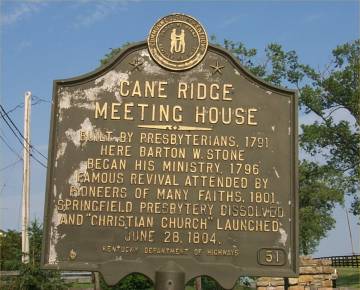
Cane Ridge
Meeting House
Built by Presbyterians, 1791
Here Barton W. Stone
Began His Ministry, 1796
Famous Revival Attended By
Pioneers Of Many Faiths, 1801.
Springfield Presbytery Dissolved
And "Christian Church" Launched
June 28, 1804.
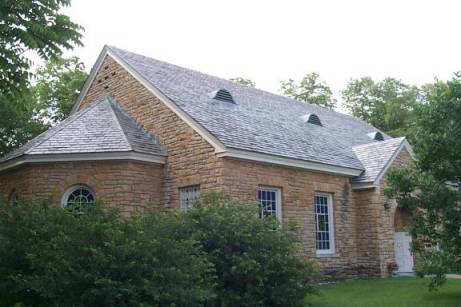
The Outer Shrine Was Built In 1964
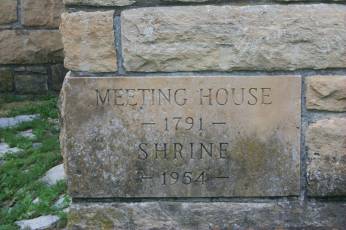
![]()
Some Scenes From Inside The Shrine
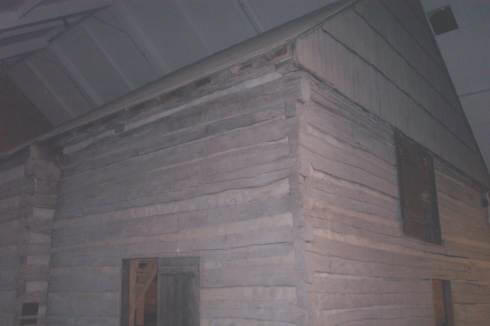
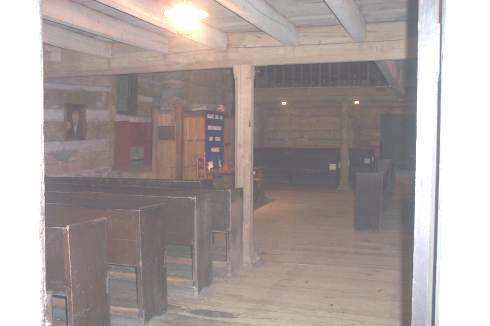
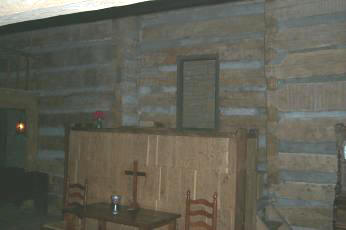
Rostrum Where Many Preachers Preached
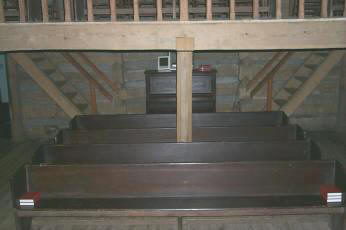
Seats In Front
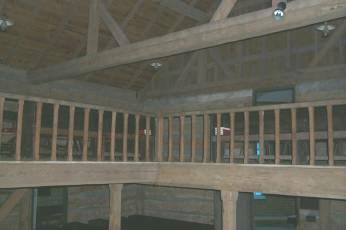
The Upper-Chamber
The Preserved Church Building
The Largest One-Room Log Cabin In America
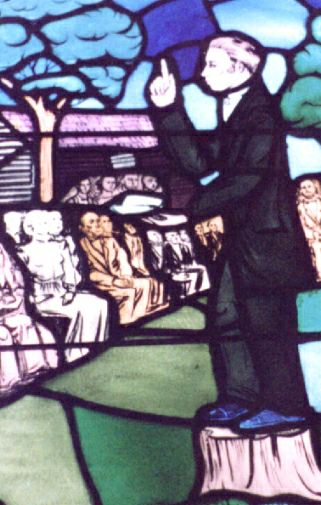
Barton W. Stone - Preacher Of Righteousness
Taken From A Painting By W.C. Bower
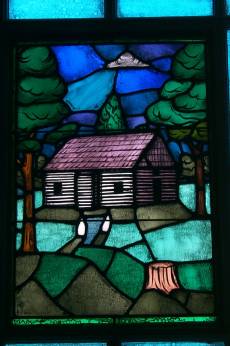
Stained Glass Inside Shrine Of How Cane Ridge Looked When It Was Built
Taken From A Painting By W.C. Bower
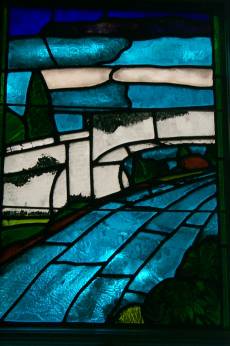
Stained Glass Rendition Of Baptismal Pool Where Stone Was Immersed -
Paris, Kentucky
Taken From A Painting By W.C. Bower
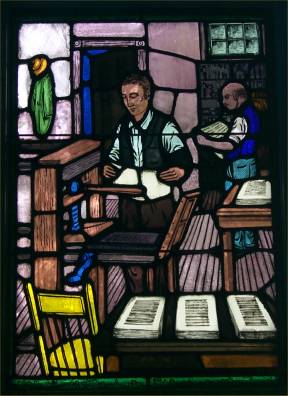
Stained Glass Rendition Of Producing
The Christian Messenger
Taken From A Painting By W.C. Bower
![]()
Burial Site Of Barton W. Stone
![]()
Cane Ridge is located north of Paris, Kentucky. If you are on Hwy 68 north of Lexington you can either go through downtown Paris and turn right on Co. 460 or go around Paris on 68 and turn right toward Paris (north of town) and then back to the left on Co. 460. Go a couple of miles and turn left on C0. 537. Go 4 or 5 miles and the Meetinghouse is on the left.
![]()


